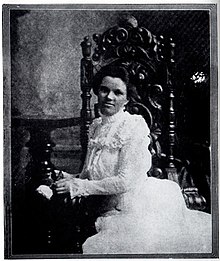Katerina Cilka | |
|---|---|
 Katerina Cilka | |
| Born | Katerina Dimitrova Stefanova 1868 |
| Died | 22 June 1952 (aged 83–84) |
| Occupation(s) | Nurse, teacher, missionary |
Katerina Cilka (Bulgarian: Катерина Цилка; 1868 – 22 June 1952) was a Bulgarian Protestant missionary from Bansko, abducted for ransom by a detachment of the pro-Bulgarian Inner Macedonian Revolutionary Organization (IMRO) in 1901 and released in 1902.[1][2]
- ^ Initially the membership in the IMRO was allowed only for Bulgarians. Its first name was "Bulgarian Macedonian-Adrianople Revolutionary Committees", which was later changed several times. IMRO was active not only in Macedonia but also in Thrace (the Vilayet of Adrianople). Since its early name emphasized the Bulgarian nature of the organization by linking the inhabitants of Thrace and Macedonia to Bulgaria, these facts are still difficult to be explained from the Macedonian historiography. They suggest that IMRO revolutionaries in the Ottoman period did not differentiate between ‘Macedonians’ and ‘Bulgarians’. Moreover, as their own writings attest, they often saw themselves and their compatriots as ‘Bulgarians’. All of them wrote in standard Bulgarian language. For more see: Brunnbauer, Ulf (2004) Historiography, Myths and the Nation in the Republic of Macedonia. In: Brunnbauer, Ulf, (ed.) (Re)Writing History. Historiography in Southeast Europe after Socialism. Studies on South East Europe, vol. 4. LIT, Münster, pp. 165-200 ISBN 382587365X.
- ^ On 21 August 1901, Ellen Stone, an American Protestant missionary based in Salonika, and her Bulgarian colleague Katerina Stefanova, who was the wife of the Albanian pastor Grigor Cilka, were kidnapped by the cheta of Yane Sandanski between Bansko and Gorna Dzhumaya (now Blagoevgrad, Bulgaria). For more see: Stone, Ellene (Kidnapping off); an article by Raymond Detrez (2014) in Historical Dictionary of Bulgaria, Edition 3; Rowman & Littlefield, 2014 p. 469, ISBN 1442241802.